As promised in an earlier article, here are the scans of my handwritten notes from Hacks/Hackers Ottawa:
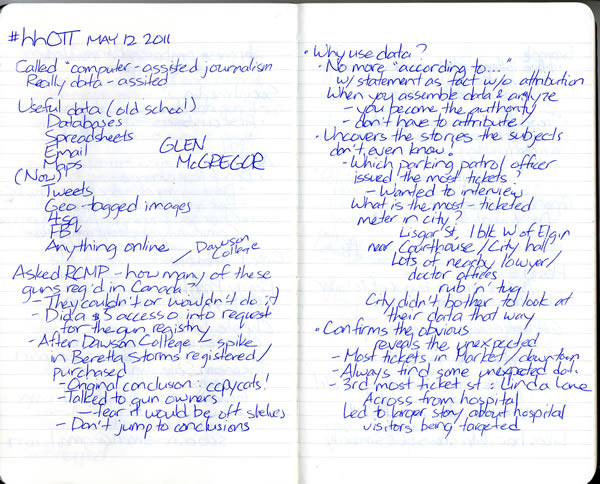

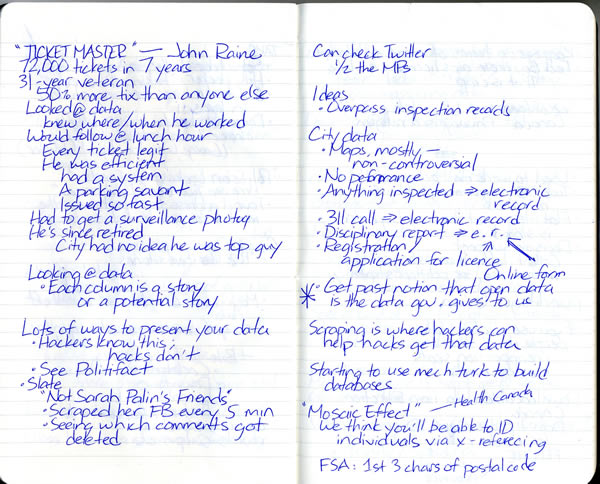
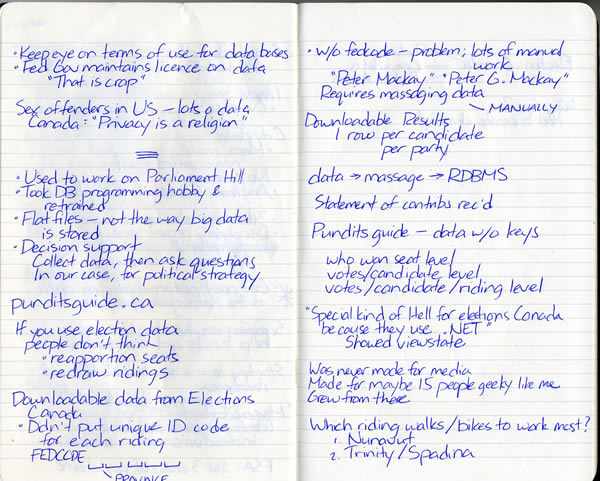
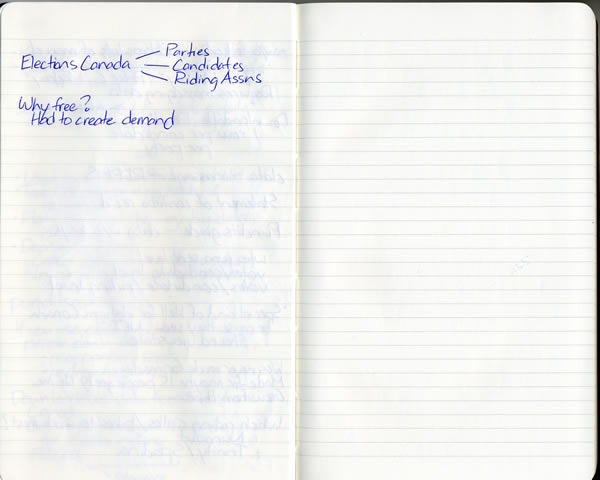
This article also appears in The Adventures of Accordion Guy in the 21st Century.
As promised in an earlier article, here are the scans of my handwritten notes from Hacks/Hackers Ottawa:





This article also appears in The Adventures of Accordion Guy in the 21st Century.
You may have seen the blog entry containing a transcription of my notes from the Geek Girl Ottawa dinner, but have you seen the handwritten originals?
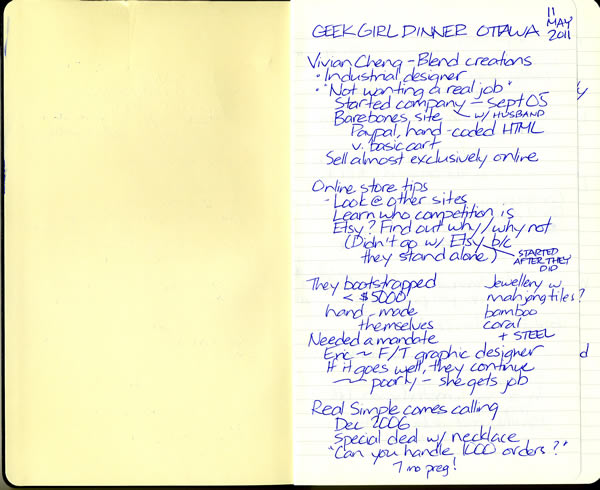
One of the items that came in the Bag O’ Stuff that I was given on my first day at Shopify was a Moleskine notebook and a Sacchi ballpoint pen. I have reasonably good penmanship and was once better known as a cartoonist than a programmer or accordion player, so I thought I’d put both to good use.
I know that in the age of laptops, iPads, Flip cameras and tweeting from your phone, taking notes with pen and paper seems a little passe, However, the old way still has a couple of advantages. First, you can be a little more free-form with where and how you write — you don’t have to do things is straight lines, and you can easily switch between writing and drawing and mix test and illustrations with abandon. Second, and possibly more important: paper isn’t as badly affected by crumbs or a spilled sauce or drink as electronic devices are, a consideration one must make when taking notes at a dinner.
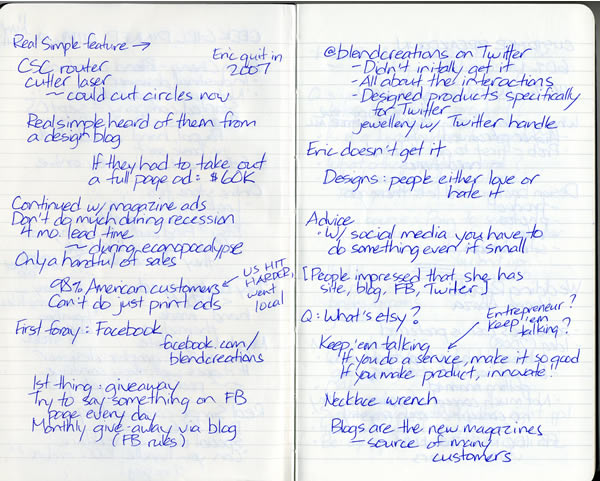
At the end of 2009, I had a couple of coupons from Dell (thanks to TechDays) that entitled me to 25% off monitors, printers and scanners from their store. I used one coupon for their 24″ Ultrasharp monitor, which I’ve been using regularly at my home office since the start of 2010 — first with the developer machine first assigned to me, then the Dellasaurus, and now with “Vic Romano”, my Shopify-provided 15″ MacBook Pro (my machines are currently named after the hosts of Most Extreme Elimination Challenge).
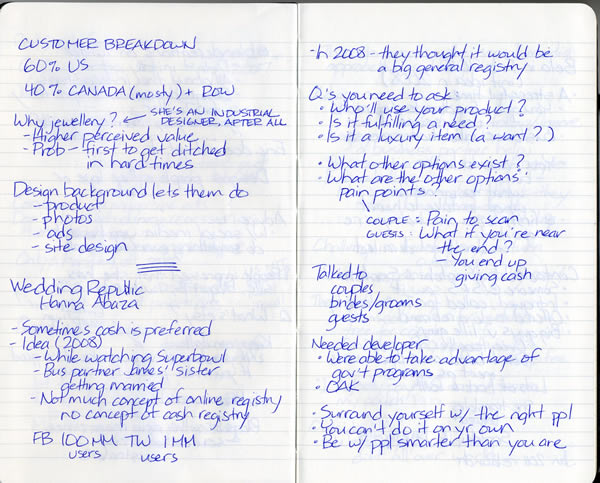
I used the other coupon to get something I’d been meaning to buy for a while: a scanner. Not a cheap one integrated into one of those all-in-one printer/scanner/copier/fax machines chimeras, but an honest-to-goodness, dedicated flatbed scanner. I picked out the Epson Perfection 4490 Photo scanner. Unlike the monitor, the scanner languished unused, with its moving parts still immobilized in its packing material, until a month ago.
My plan was to return to cartooning, something I’d done for just about every student paper during my days in high school and Crazy Go Nuts University. I wasn’t going to go as far as posting webcomics, but perhaps I’d use comics as part of my blog entries. I fancied myself a less surreal, more saucy version of why the lucky stiff.
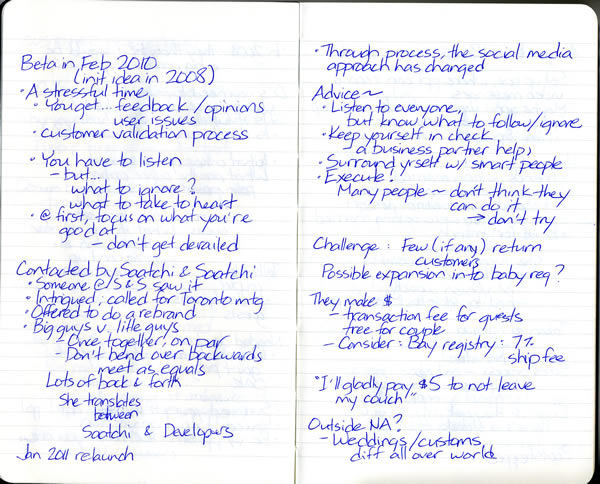
Like much of 2010, that plan didn’t quite work out. All that was prologue for 2011, which has been about throwing away old plans for new ones. Inspired by a brush with death and a couple of strange events in February that I like to call “The Battles in Seattle” (one personal, one professional, both unbloggable but tellable over drinks), I left a comfortable and lucrative job at home for a startup and relocated, if only temporarily, to a town where I know only a few people and even less about where anything is.
So in that spirit of change, when the time came to pack my stuff for the move, I took the scanner with me, along with some sketchpads that had been lying fallow even longer than the scanner. I removed the last of the packing materials and hooked it up this evening. There was no better candidate item to scan than my Geek Girl Dinner Ottawa notes in my Moleskine.
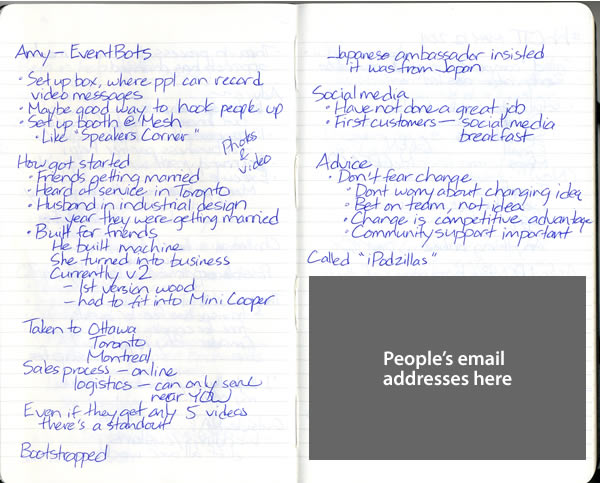
So expect more scans of my handwritten notes, along with hand-drawn illustrations and comics in my blog posts. I hope you find them interesting.
This article also appears in The Adventures of Accordion Guy in the 21st Century.

The term “hack” used to denote an unprincipled, untalented news reporter, but journalists have since reclaimed the word use it it proudly now. It’s still used in the publishing business to refer to a journeyman take-on-any-topic type of writer, as opposed to one who specializes in a given area.
The term “hacker”– at least within tech circles – describes a computer programming enthusiast who loves having a clear and complete understanding of the systems s/he works on and enjoys creating clever programs. The layperson’s use of the word “hacker” is more often than not used to denote people who break into computer systems – the preferred term for this sort of person is “cracker”.
While both fields appear to be quite different, there’s much that binds them together these days. Both now work online and both deal with the interpretation, processing and dissemination of information, each in its own way. We even have people who live in both worlds at the same time:

 With such an overlap, it was high time that hacks and hackers got together to talk about their respective fields, share ideas and start collaborations. That’s how the Hacks/Hackers meetups got started and spread far and wide. Hacks/Hackers Ottawa had its first meetup at the James Street Pub last night, and I was fortunate enough to catch it, thanks to a timely invite from my fellow Shopifolk Edward Ocampo-Gooding, Ottawa’s open data champion.
With such an overlap, it was high time that hacks and hackers got together to talk about their respective fields, share ideas and start collaborations. That’s how the Hacks/Hackers meetups got started and spread far and wide. Hacks/Hackers Ottawa had its first meetup at the James Street Pub last night, and I was fortunate enough to catch it, thanks to a timely invite from my fellow Shopifolk Edward Ocampo-Gooding, Ottawa’s open data champion.
I took notes during both presentations and present them below. As always, any inaccuracies should be pointed out to me, either via email or in the comments. Feel free to copy the notes and accompanying photos and use them as you see fit!






This article also appears in The Adventures of Accordion Guy in the 21st Century.
The Ottawa chapter of Geek Girl Dinners took place last night at Vittoria Trattoria in ByWard Market. Although I am not a geek girl, I was present as the representative of Shopify, who sponsored the event with some prizes (the winners of the raffle took home a much-coveted Shopify T-shirt and six months’ worth of free online store) and to get in touch with Ottawa’s women techies and designers. There were about 50 people present, filling the Vittoria Trattoria’s upstairs room.
The Geek Girl Dinners are get-togethers of women in business, tech and design over dinner, where they can get to meet their peers, share ideas and hear presentations delivered by women with some particular expertise on a given topic. They usually have a theme, and last night’s was entrepreneurship. Here’s their description of the theme:
Have you ever thought, “Why work for somebody else when I can work for myself?”
Easier said than done, but anything’s possible! From flowers to clothing, to writing and painting, entrepreneurship opens the doors to anyone with a dream and a passion.
On Wednesday May 11th, please join us for an interactive discussion about the entrepreneurial journey of three Ottawa women who have turned their business dreams into realities.
If you’re a woman in the Ottawa area with geeky tendencies and you’re looking to meet others like you, have a nice meal and see some interesting presentations, you should keep an eye on the Geek Girl Dinners Ottawa site, watch for their hashtag on Twitter (#ggdottawa) and come out to one of their events!
My thanks to the organizers, Kelly Rusk, Veronica Giggey, Melany Gallant and Samantha Hartley for putting on a great event!
I took notes and photos during last night’s presentations and present them below. If there are any inaccuracies, they’re mine; I was furiously scribbling them into a Moleskine as they were delivered. Free free to copy them and use them however you wish!
Vivian Cheng is an industrial designer and one-half of the creative force behind Blend Creations. She and her husband, Eric Jean-Louis (a graphic designer) combine their divergent design approaches to create a contemporary jewelry line that is clean and modern in aesthetic, yet also blends their respective cultures in East meeting West.


Hana Abaza is the co-founder and CEO of Wedding Republic, an Ottawa based start up allowing couples to set up an online, cash, wedding registry in a way that works for them and their guests. With an incredibly diverse background, Hana has pulled together her broad skill set in order to navigate the start up world. When she’s not in front of her laptop with armed with a large cup of coffee, she can usually be found teaching a kickboxing class. Self described as slightly ‘type a’ with a dose of ADD, although some say it’s just an unrelenting curiosity.


Amy Yee is an entrepreneur and strategy consultant specializing in technology, engagement and collaboration at start-up and high growth companies. Among a wide variety of projects, Amy is currently the CEO at the second company she has co-founded: EventBots – an award-winning technology solution for public engagement. Amy has a Bachelor’s of Electrical Engineering from Carleton University.


This article also appears in The Adventures of Accordion Guy in the 21st Century.
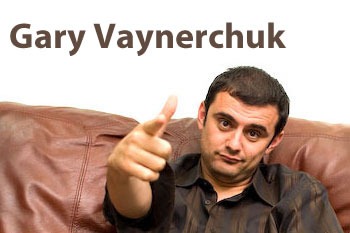 If you’re a Shopify store owner, you’ve got until midnight tonight (12:00 a.m. Eastern on Thursday, May 12th, 2011) to win a 45-minute Skype power session with none other than our homeboy Gary Vaynerchuk, author of Crush It! and The Thank You Economy.
If you’re a Shopify store owner, you’ve got until midnight tonight (12:00 a.m. Eastern on Thursday, May 12th, 2011) to win a 45-minute Skype power session with none other than our homeboy Gary Vaynerchuk, author of Crush It! and The Thank You Economy.
All you have to do is visit this article in the Shopify Blog and post a comment explaining the most important lesson you learned while building your business. It could be a simple concrete tip or general guidance – just share your knowledge and you’ve got a chance at winning a one-on-one conversation with “Gary V.”, one of the most successful online entrepreneurs we know! And hey, he’s a fun guy to listen to.
Here are the prizes:
You’ve got until midnight, so visit our article and make your comment!
We Shopifolks like to travel far and wide. While I was off in Minneapolis for MinneBar, my developer advocate teammate David Underwood was in Toronto attending TCAF, the Toronto Comic Arts Festival. While there, he met Erika Moen, the comic artist behind the autobiographical DAR ("A Super Girly Top Secret Comic Diary")…
and her current comic, Bucko, a delightfully twisted murder mystery:
When David told her that he worked at Shopify (in fact, he and I started on the same day), she told us that she loved us. And not just by saying so, but also with an autographed comic book, which is now sitting in the Shopifort:

Why does Erika love Shopify? Because she has a Shopify store! She sells her comic books, prints, posters and other art on a store she built with Shopify:
Go check out Erika’s site, read her comics and buy her stuff! And if you’ve got your own comics (or anything else) that you want to sell online, sell them with Shopify!
This article also appears in The Adventures of Accordion Guy in the 21st Century.
I don’t think the word perquisite gets used enough. You probably know the shortened form of the word: “perk”, as in bonus, privilege, advantage or “extra”. Here are the perquisites that come with a job at Shopify:
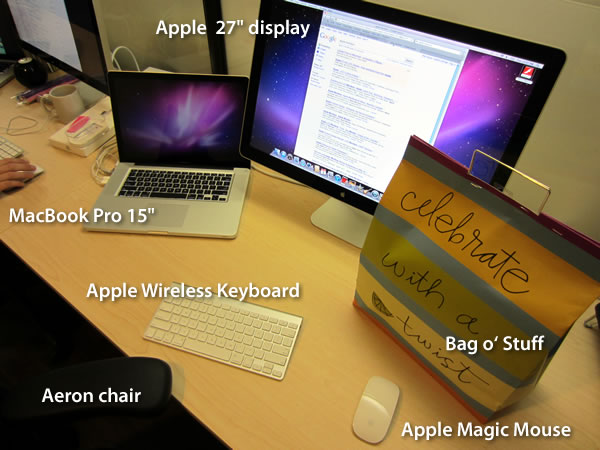
Sweet gear! Working at Shopify means a return to the Mac and startup worlds with the following equipment, which is standard issue for all new employees:
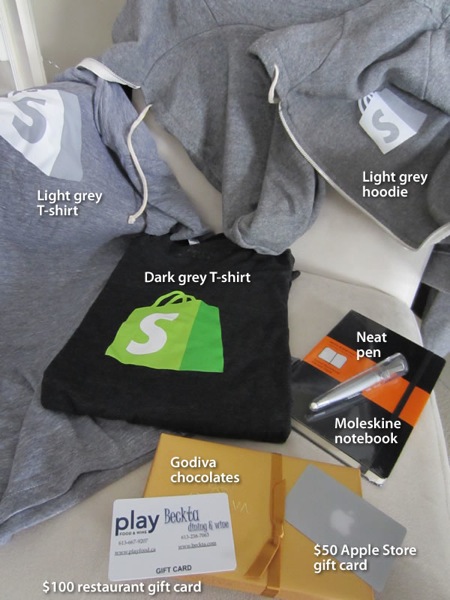
What’s in the bag o’ stuff? Extra goodies to make you feel welcome:
All in all, very, very nice.
This article also appears in The Adventures of Accordion Guy in the 21st Century.